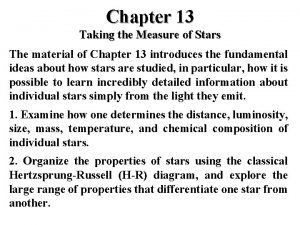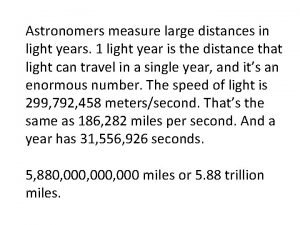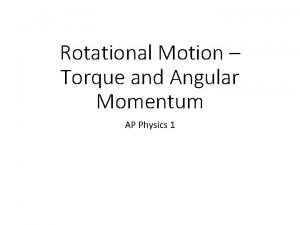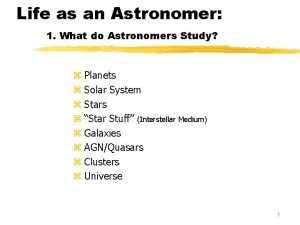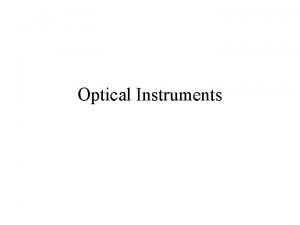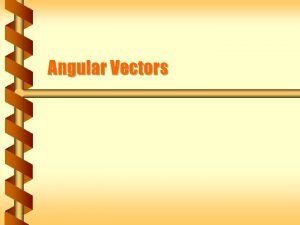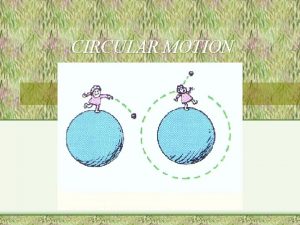Angular size and resolution Astronomers usually measure sizes










- Slides: 10

Angular size and resolution • Astronomers usually measure sizes in terms of angles (not lengths) – This is because distances are seldom well known • For small angles “theta”: – tan(theta) = sin(theta) = theta – theta = S/D where S is the distance between 2 objects and D is the distance from observer to the objects S theta D

Angles: units of measure • theta = S/D will yield angle in radians – there are 2*pi (or roughly 2*3. 1416) radians in a circle – so 1 radian = 57 degrees • degrees are often too big a unit to be useful – 1 degree = 60 arc minutes; 1 arc minute = 60 arc seconds – 1 degree = 3600 arcsec – 1 radian = 2 x 105 arcsec

Angular yardsticks • Easy yardstick: your fist – fist held at arms’ length subtends angle of about 5 degrees • Easy yardstick: the Moon – Moon’s disk: 1/2 degree in diameter (same for Sun) – Moon’s disk is about 1/100 of a radian – Moon’s disk is 30 arcmin or 1800 arcsec

Telescopes and magnification • Telescopes serve to magnify distant scenes • Magnification = increase in angular size • Simple refractor telescope (such as was used by Galileo and Kepler and contemporaries) involves use of 2 lenses – objective lens: performs light collecting and forms intermediate image – eyepiece: acts as magnifying glass to form magnified image that appears to be infinitely far away

Telescopes and magnification • Ray trace for refractor telescope demonstrates how the increase in magnification is achieved – Seeing the Light, pp 169 -170, 422 • From similar triangles in ray trace, can show that magnification = -f(obj)/f(ep) – f(obj) = focal length of objective lens – f(ep) = focal length of eyepiece – note that magnification is negative: image is inverted

Magnification: requirements • Unaided eye can distinguish shapes/shading on Moon’s surface (angular sizes of a few arc minutes) • To increase Moon from “actual size” to “fist size” requires magnification of 10 (typical of binoculars) – with binoculars, can easily see shapes/shading on Moon’s surface (angular sizes of 10’s of arcseconds) • To see further detail you can use a small telescope w/ magnification of 100 -300 – w/ small telescope can distinguish large craters (angular sizes of a few arc seconds)

Aside: parallax and distance • The only direct measure of distance astronomers have for objects beyond the solar system is parallax – Parallax: apparent motion of nearby stars (against a background of very distant stars) as Earth orbits the Sun – Requires taking images of the same star at two different times of the year Background star Foreground star CAUTION: NOT TO SCALE

Parallax as a distance measure Reference star Image 1 Parallax (P) Image 2 (6 months later) • Apparent motion of 1 arcsec is defined as a distance of 1 parsec (parallax second) – 1 parsec (pc) = 3. 26 light years – 1 light year = distance light travels in 1 year • 1 parsec = 3. 26 * 60 sec * 60 min * 24 hrs * 365 days * 3 x 105 km/sec • so, 1 parsec (pc) is roughly 3 x 1013 km (about 20 trillion miles) • D = 1/P where D is distance in pc, P is parallax in arcsec

Magnification: limitations • Can you use a small telescope (or a large one for that matter) to increase the angular size of the nearest star to the angular size of the Sun? – nearest star, alpha Cen, has physical diameter similar to Sun but a distance of 1. 3 pc (4. 3 light years), or about 1. 5 x 1013 km from Earth – Sun is 1. 5 x 108 km from Earth – => required magnification is 100, 000

Magnification: limitations • Can one magnify images by arbitrarily large factors? • Increasing magnification involves “spreading light out” over a larger imaging (detector) surface – necessitates ever-larger light-gathering power • Before this become problematic, most telescope hit their diffraction limit – limiting angle roughly equal to lambda/D radians, where lambda is wavelength and D is telescope diameter • Typically, before diffraction becomes a problem, the atmosphere becomes a nuisance – most telescopes limited by “seeing”: image smearing due to atmospheric turbulence
 Men's shirt sizes are determined by their neck sizes
Men's shirt sizes are determined by their neck sizes Astronomers measure the masses of stars by
Astronomers measure the masses of stars by Astronomers measure large distances
Astronomers measure large distances Portrait resolution sizes
Portrait resolution sizes Ap physics 1 angular momentum
Ap physics 1 angular momentum High resolution low resolution
High resolution low resolution An instrument used to measure temperature
An instrument used to measure temperature What do astronomers study
What do astronomers study Modern telescopes make it possible for astronomers
Modern telescopes make it possible for astronomers The size of the jhsc usually depends on
The size of the jhsc usually depends on Is measure for measure a comedy
Is measure for measure a comedy

